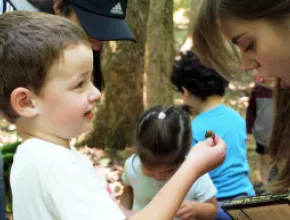The National Fish and Wildlife Foundation (NFWF) joined partners from the public and private sectors to announce nearly $91 million in grants through the America the Beautiful Challenge. (ATBC). The 55 grants will support landscape-scale conservation projects in 42 states and three U.S. territories, leveraging $50.7 million in matching contributions to generate a total conservation impact of about $141.7 million.
ATBC grants support projects that conserve, restore, and connect habitats for wildlife while improving community resilience and access to nature. The America the Beautiful Challenge is a partnership between NFWF and the U.S. Department of the Interior through the Fish and Wildlife Service, the U.S. Department of Agriculture through the Natural Resources Conservation Service and the Forest Service, the U.S. Department of Defense, and Native Americans in Philanthropy.
“Nature is essential to the health, well-being, and prosperity of every family and every community in America,” said Secretary of the Interior Deb Haaland. “Through the America the Beautiful Challenge, we are investing in projects that advance collaborative conservation utilizing the best available science, innovative practices, and indigenous knowledge to help conserve and protect our lands and waters. This work will create jobs, strengthen our economy, address equitable access to the outdoors, and help tackle the climate crisis.”
Examples of projects funded by the grants include:
- Restoring Canyon Creek Stream Flow and Function for Fish, Wildlife and Water Uses (Idaho): Friends of the Teton were granted $815,000 with $955,000 in matching funds to restore instream flow and improve irrigation infrastructure impacting Canyon Creek, upstream to the Caribou-Targhee National Forest, a major spawning tributary for a source population of Yellowstone cutthroat trout in the Teton River Watershed. The project aims to improve water quality and ecosystem function, and will collaboratively address water supply and ecosystem needs for an entire sub-watershed.
- Habitat Management, Wildfire Mitigation and Engaging Communities in the Georgia Sentinel Landscape (Georgia): The Georgia Forestry Commission was granted $1.046 million to conduct prescribed burns, identify historically underserved communities to assist with wildfire mitigation, complete at least 10 stewardship management plans per year, and support a workshop and expo event. The project will enhance resilience in the longleaf pine ecosystem through restorative fire management.
- Invasive Species Management in National Forests Along the Appalachian Trail (Georgia, North Carolina, Tennessee, Virginia, and West Virginia): The Appalachian Trail Conservancy was granted $515,800 with $116,000 in matching funds to monitor and remove non-native invasive plants and protect endangered ash trees in national forest sites within the Appalachian National Scenic Trail corridor. The project will engage volunteers and Service Corps crews in on-the-ground activities to improve the ecological health of national forests in the Appalachian Mountains.
- Keya Wakpala Woicageyapi Wetlands Restoration and Nature-Based Community Engagement (South Dakota): The Rosebud Economic Development Corporation was granted $536,500 with $16,100 in matching funds to design the first phase of the Keya Wakpala Woicageyapi wetlands restoration project and connect the broader Sicangu community to restoration and conservation efforts in a culturally aligned and meaningful way. The project will produce a community-driven wetlands trail plan, an ecological inventory assessment informed by wildlife habitat priorities and culturally relevant food and medicine needs, and incorporate indigenous ecological knowledge for the site.
To streamline and centralize access to the grant funds, NFWF and partners worked together to establish the ATBC in May 2022 as a “one-stop-shop” competitive grant program for landscape-scale conservation and restoration projects that implement existing conservation plans across the nation. The 2022 ATBC request for proposals received an unprecedented response, with applicants submitting 527 proposals requesting a total of $1.1 billion. The grant slate announced today addresses about 10% of this overall level of demand, illustrating the highly competitive nature of the ATBC.
“The inaugural year of the America the Beautiful Challenge shows what’s possible when partners go all-in on a collaborative approach to providing resources for locally led restoration efforts,” said Jeff Trandahl, executive director and CEO of NFWF. “These grants will support voluntary landscape-scale conservation efforts that will restore fish and wildlife habitats across the nation and build a brighter future for all of us.”
The grants enable states, Tribal nations, U.S. territories, nonprofits, academic institutions and other grantees to develop and implement multijurisdictional, high-priority restoration projects on both public and private lands. The program is intended to encourage the development and implementation of diverse and comprehensive landscape-level projects that:
- Address priority conservation and restoration needs.
- Showcase cumulative benefits to fish and wildlife.
- Enhance carbon sequestration and storage.
- Engage with and benefit underserved communities.
- Connect people with nature.
- Advance existing conservation plans and/or are informed by indigenous traditional knowledge.
- Help safeguard ecosystems and communities through resilience-focused and nature-based solutions.
“Restoring and maintaining 193 million acres of national forests and grasslands and conserving hundreds of thousands of acres of agricultural and private lands is a task too large for any one organization to do alone,” said Agriculture Secretary Tom Vilsack. “That is why we have long worked with a wide array of partners and our co-stewardship agreements with Tribal nations help bridge the gap between what we can accomplish ourselves and the work we all know needs to get done together. These grants help make those connections possible.”
The ATBC includes an emphasis on supporting Tribal nation access to grant funding for restoration, conservation and capacity-building, and seeks projects that incorporate indigenous traditional knowledge in planning and implementation. The number of proposals received from Tribal nation applicants in 2022 far exceeded expectations and demonstrated high demand and clear need for the funding. Ultimately, about one-third of the 2022 grants and funding will support projects implemented by Tribal nations, representing an unprecedented level of funding dedicated to Tribally led projects for a single grant program at NFWF. This includes the largest-ever grant made by the Foundation to a Tribal nation.
“Many global philanthropic investments in indigenous conservation efforts neglect U.S. based Tribes. Despite underfunding, Tribes consistently demonstrate that they are the best stewards of their lands and waterways, using indigenous ecological knowledge and their unique legal and political relationship with the U.S. government,” said Erik Stegman, CEO of Native Americans in Philanthropy.
The ATBC consolidates funding from multiple federal agencies and the private sector, enabling applicants to develop and pursue large-scale or complex, locally led projects that collaboratively address shared priorities across public and private lands. The program supports projects that contribute to one or more of the following focal areas:
- Conserving and restoring rivers, coasts, wetlands, and watersheds.
- Conserving and restoring forests, grasslands, and other important ecosystems that serve as carbon sinks.
- Connecting and reconnecting wildlife corridors, large landscapes, watersheds, and seascapes.
- Improving ecosystem and community resilience to flooding, drought, and other climate-related threats.
- Expanding access to the outdoors, particularly in underserved communities.
The competitive grant awards were made possible with funding from the Bipartisan Infrastructure Law, other federal conservation programs and private sources. Additional support this year was provided by the Bezos Earth Fund.




